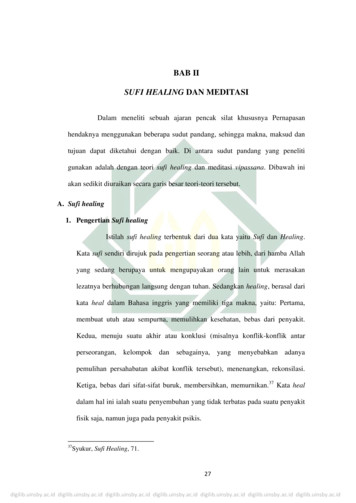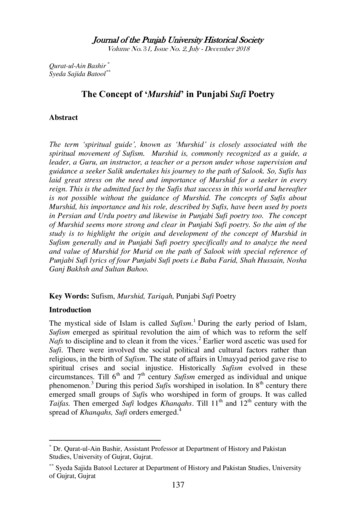Sufi Meditation - BahaiStudies
Sufi MeditationA traditional Sufi meditation practice for experiencing ourconnection with God (Allah), taught by Jewish Sufi teacherMurshid Netanel Miles-Yepez.As with many spiritual traditions, Sufi meditation actuallycovers a spectrum of practices, which, like the concept ofmeditation itself, are often difficult to distinguish. Thesepractices include: dhikr, the mantric recitation of divinenames; fikr, linking these names with breathwork;murraqaba, the meditative technique of stilling the mind;muhasaba, contemplation or discursive meditation; andwird, Sufi prayers. Of course, the most characteristicmeditative practice of Sufism is dhikr, or “remembrance.”This is a practice of repeating one of the wazaif, sacredphrases or divine names, to create a kind of “fly-wheel” inconsciousness, so that one is in continuous remembrance ofGod—Allah. On another level, this practice may also lead toa melting away of all discursive functioning, leaving onlyinterior silence and the presence of God. Dhikr can beperformed in a variety of ways, vocally (dhikr jahri) or insilence (dhikr khafi). Often different Sufi orders are evendistinguished by the style of their dhikr; for instance, QadiriSufis are known for their passionate vocal dhikr. Moreover,most Sufi orders have a distinctive mode of vocalizing thephrase, “no god,” but God—la illaha illa-lah, sometimeswith accompanying movements. This is done both as a group
and a solitary practice, and usually with the aid of a tasbih, astring of ninety-nine beads carried by most Sufi initiates.Though fikr is sometimes used as a general term forcontemplation, its more particular usage has to do withlinking the remembrance of the sacred phrase, or wazifa(singular form of wazaif), with the rhythm of the breath, sothat “not a single breath passes without the remembrance ofGod.” Because the wazifa is remembered silently in fikr, it isalso known as dhikr al-qalbi, the “remembrance of theheart.” In some orders where dhikr al-qalbi is the dominantmode of practice, it is sometimes said that remembrance is aspiritual wine, and that doing it aloud is like spilling thewine down your shirt, while silent recitation allows it to flowdirectly into the heart, creating holy intoxication. Onesimple, effective practice used among Universalist Sufis, is toput the English phrase “Toward the One on the breath:”Without changing your breathing pattern, begin to think“Toward the One” with each inhalation and exhalation; asyou breathe in and out, identify with the breath going in andout of your body; now, make the length of your inhalationand exhalation even, breathing in a calm and refinedmanner; continue in this manner for at least ten minutes.The practice of meditation as it is popularly understood, thatis to say, as a breathing or concentration practice leading tothe stilling of the mind, is known as murraqaba in Sufism. Insome ways, this is a false distinction, as dhikr, fikr,muhasaba, and even wird may also lead to the stilling of themind and the opening to the Divine. Nevertheless, in terms oftechnique, murraqaba has most in common with the more
familiar yogic concentration and breathing practices foundin Hinduism and Buddhism. Murraqaba ranges fromspecific concentration techniques focusing on objects andimages, to techniques focusing on the breath, especially indifferent lengths of inhalation, exhalation, and retention.Both murraqaba and fikr are also done as walkingmeditation practices.Muhasaba is a word that has to do with “balancingaccounts” and “precise calculation” and is used in twosenses: self-examination, or taking account of one’s ownpersonal thoughts and actions; and, a thorough examinationof spiritual ideas and ideals, contemplating them in adiscursive meditation. As mentioned before, fikr, meaningreflection, is in some ways a better word for the latter type ofcontemplation. Nevertheless, the accounting quality ofmuhasaba tells us something important about the nature ofdiscursive meditation, i.e., that it must be more than simplereflection, a deeply penetrating, thorough examination of aconcept in all its details, including all of its associatedthoughts and feelings.The final meditative practice of Sufism is wird, the prayer ofthe Sufis. This is prayer apart from salat, the normativeprayer practice of Islam, or from any other tradition. Extraor supererogatory prayers such as these are usually callednawafil, but wird has a more specific usage in Sufism, beingthe prescribed prayers of particular Sufi order, the dailywork of its adherents. While prayer is not generallyassociated with meditation, in Judaism, Christianity, andIslam, at least, it has never really been separate from
meditation. For it has long been acknowledged in thesetraditions that there are deeper levels of prayer that lead toecstasy, to profound contemplation, and even to interiorsilence.Murshid Netanel Miles-Yepez is a scholar of comparativereligion, a Sufi teacher, and the cofounder of the SufiHasidic, Inayati-Maimuni Tariqat. He is the editor of TheCommon Heart: An Experience of Interreligious Dialogue(2006) and Living Fully, Dying Well: Reflecting on Death toFind Your Life’s Meaning (2009).Notes on Sufi Article 1. The classic description of dhikr isfound in Abu Hamid Muhammad al-Ghazzali’s Deliverancefor Ignorance, nicely translated in Massud Farzan’s The Taleof the Reed Pipe: Teachings of the Sufis. New York: E.P.Dutton & Co., 1974: 51-52. 2. See the interesting discussionof vocal and silent dhikr in relation to the successors ofMuhammad in Gregory Blann’s The Garden of Mystic Love:Sufism and the Turkish Tradition. Nashville, TN: SundogPress, 2005: 14-15. 3. Javad Nurbakhsh. In the Paradise ofthe Sufis. New York: Khaniqahi-Nimatullahi Publications,1979: 34. 4. Paraphrased from Javad Nurbakhsh’s In theParadise of the Sufis. New York: Khaniqahi-NimatullahiPublications, 1979: 34-35. 5. Universalist Sufism is aperennial Sufism associated with the first Sufi to come intothe West, Hazrat Inayat Khan (d.1927). “Toward the One isthe first line of his famous prayer of the same namecomposed in English. 6. Perhaps the most accessiblepresentation of a Sufi murraqa practice is found in PuranBair’s Living from the Heart: Heart Rhythm Meditation. New
York: Three Rivers Press, 1998. Another excellenttraditional presentation is found in Nurjan Mirahmadi’s TheHealing Power of Sufi Meditation. Detroit, MI: IslamicSupreme Council of America, 2005.
Sufi Meditation A traditional Sufi meditation practice for experiencing our connection with God (Allah), taught by Jewish Sufi teacher Murshid Netanel Miles-Yepez. As with many spiritual traditions, Sufi meditation actually covers a spectrum of practices, which, like the concept of meditation itself, are often difficult to distinguish. These
Healing Power of Sufi Meditation Videos Many of these ancient Sufi masters' writings were only in Arabic and used terms that were complex and unfamiliar to Western people. Such as Taffakur, Tadhakkur, Muraqabah, Muhasabah, Insan Kamel by masters such as Imam Gazalli, Ibn Arabi, Hadrat Abdul Qadir a Gilani all the Saints of the Naqshbandi Sufi Way.
Méditation bouddhique 1 Méditation bouddhique Le Bouddha Shâkyamouni en méditation. La méditation bouddhique, méditation théorisée et pratiquée dans le bouddhisme, diffère radicalement de la méditation dans son acception occidentale. Son but ultime est l'atteinte du nirvāṇa. Le mot le plus proche pour « méditation » dans les langues classiques du bouddhisme est bhavana, qui .
genuine Sufi expert and by our finest Sufi instructors. Students will have the opportunity to learn about the techniques of Sufi healing meditation, the fundamentals of Sufism and of fiqh, the mystical aspect of Sufi music, whirling and spiritual poetry, and the basics of the Quranic recitation.
meditation with relative and empirical meaning of Bensonian Relaxation Response (RR) (Kim, 2005). Meditation has two main approaches, intensive meditation and mindfulness meditation (Hussain, et al. 2010). Intensive meditation aims to focus on any sound, image or sensation. Transcendental Meditation (TM), developed by Maharshi
Meditation is one of the most confusing disciplines. Hundreds of books are written about meditation. We should know - what meditation is meant for and what meditation is not meant for. What is Meditation not meant for? i. Meditation is not meant for liberation or spiritual freedom, because
Sufi healing (pengobatan sufi) merupakan salah satu cara yang digunakan oleh para sufi dalam pengobatan dan penyembuhan, dimana pengobatan dan penyembuhan tersebut menggunakan metode-metode yang berdasarkan keagamaan yaitu dengan mbangkitkan potensi keimanan kepada Tuhan, lalu menggerakkannya ke arah pencerahan batin atau pencerahan rohani .
Sufism generally and in Punjabi Sufi poetry specifically and to analyze the need and value of Murshid for Murid on the path of Salook with special reference of Punjabi Sufi lyrics of four Punjabi Sufi poets i.e Baba Farid, Shah Hussain, Nosha Ganj Bakhsh and Sultan Bahoo. Key Words: Sufism, Murshid, T
The dynamics of group size is an important component of group work. A small group is often considered to consist of three or more people (Beebe & Masterson, 2003). Groups of two are called dyads and are not encouraged for group work because there are not a sufficient number of individuals to generate creativity and a diversity of ideas (Csernica et al., 2002). In general, it is suggested that .























